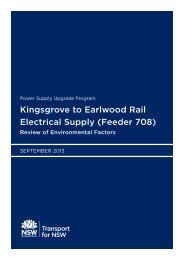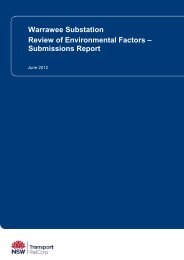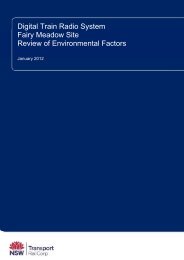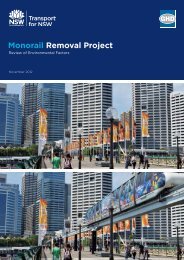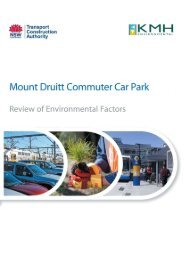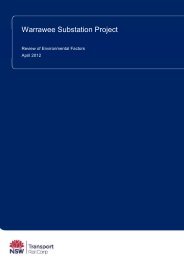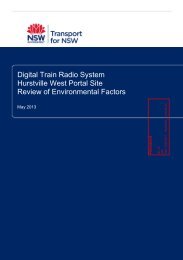Northern Beaches Bus Rapid Transit Pre-Feasibility Study
Northern Beaches Bus Rapid Transit Pre-Feasibility Study
Northern Beaches Bus Rapid Transit Pre-Feasibility Study
Create successful ePaper yourself
Turn your PDF publications into a flip-book with our unique Google optimized e-Paper software.
<strong>Northern</strong> <strong>Beaches</strong> <strong>Bus</strong> <strong>Rapid</strong> <strong>Transit</strong><br />
(BRT) <strong>Pre</strong>-<strong>Feasibility</strong> <strong>Study</strong><br />
Summary Report
Contents<br />
1. Introduction 1<br />
2. Development of options 3<br />
2.1 Shortlist of options 4<br />
2.2 Travel time improvements 6<br />
3. North-South Corridor 7<br />
3.1 Option 1: North-South Priority Works 9<br />
3.2 Option 2: North-South Median BRT 11<br />
3.3 Option 3: North-South Kerbside BRT 13<br />
3.4 Option 4: North-South <strong>Northern</strong> Interchange BRT 15<br />
3.5 Option 5: North-South Tunnel BRT 17<br />
3.6 Tidal flow options 19<br />
4. East-West Corridor 20<br />
4.1 Option 6: East –West Kerbside BRT 22<br />
5. <strong>Bus</strong> Network Considerations 24<br />
5.1 North-South Corridor: <strong>Bus</strong> Network Rationalisation 25<br />
5.2 East-West Corridor: Proposed <strong>Bus</strong> Network 27<br />
6. Summary of key findings 28<br />
<strong>Northern</strong> <strong>Beaches</strong> <strong>Bus</strong> <strong>Rapid</strong> <strong>Transit</strong> (BRT) <strong>Pre</strong>-<strong>Feasibility</strong> <strong>Study</strong> i Summary Report
Executive Summary<br />
The NSW Government made a commitment to examine the feasibility of <strong>Bus</strong> <strong>Rapid</strong> <strong>Transit</strong> (BRT) for the<br />
<strong>Northern</strong> <strong>Beaches</strong> of Sydney. This report provides a summary of the findings from a pre-feasibility study<br />
undertaken in response to that commitment.<br />
The initial scope of the study was to assess the feasibility of BRT on the North-South Corridor between the<br />
<strong>Northern</strong> <strong>Beaches</strong> and the Sydney CBD but it was extended to also include the East-West Corridor<br />
between Chatswood and Dee Why. This was in response to the Shore Regional Organisation of Councils<br />
(SHOROC) which considered the East-West Corridor a priority for investment because increased capacity<br />
on that route could take pressure off the North-South Corridor.<br />
The two main problems with public transport services in the region are:<br />
reliability and travel time variability of current bus services (buses between Spit Junction and Wynyard<br />
can vary from timetable by 15 to 20 minutes)<br />
slow travel speeds of buses in the peak periods.<br />
<strong>Bus</strong> priority measures already operate on the North-South Corridor. Key components include: a continuous<br />
dedicated bus lane between Mona Vale and Seaforth; transit lanes; intersection upgrades; and, bus<br />
priority at traffic signals. Further work has been planned and is programmed for implementation.<br />
On the East-West Corridor, dedicated bus lanes are in operation on three sections of the route and bus<br />
priority is provided at one intersection.<br />
The study initially assessed 15 BRT options that would improve bus travel speeds and operations in the<br />
peak and off peak periods and increase the overall use of public transport to meet existing and future<br />
demand on both corridors. Six of these were short listed for further analysis. None of the short listed<br />
options require widening of the road except for bus stops and at intersections and in some cases to widen<br />
bridges.<br />
The results of the analysis indicate the six short listed options are effective in reducing trip times and trip<br />
time variability for public transport users. A rapid economic appraisal shows the costs of the BRT options<br />
are higher than the benefits. This is partly because dedicating additional road space to BRT will reduce the<br />
space available and increase congestion for private vehicles.<br />
The options all assume bus priority 24 hours a day. In practice this would be a ‘final state’ (or may not be<br />
required along the full length of the corridor) and in the interim bus priority measures would apply for a<br />
shorter period of the day and/or parts of the corridors would be shared with general traffic as options are<br />
delivered incrementally. More detailed appraisal of options accounting for this variation would most likely<br />
reduce the costs relative to the benefits. The options could also be expanded to include options that are<br />
broader than BRT measures. For example, a general traffic tunnel under Military Road could be further<br />
considered – this option was not shortlisted although it ranked highly in an initial multi-criteria analysis<br />
because it was considered out of scope of BRT measures.<br />
Several options are feasible from a construction and deliverability perspective and implementing preferred<br />
options using a staged approach coupled with re-configuring existing services could increase the<br />
economic viability of progressing BRT on the <strong>Northern</strong> <strong>Beaches</strong>.<br />
The NSW Government is seeking comment on the options considered in the pre-feasibility study.<br />
<strong>Northern</strong> <strong>Beaches</strong> <strong>Bus</strong> <strong>Rapid</strong> <strong>Transit</strong> (BRT) <strong>Pre</strong>-<strong>Feasibility</strong> <strong>Study</strong> i Summary Report
1. Introduction<br />
This summary report outlines the findings of the <strong>Northern</strong> <strong>Beaches</strong> <strong>Bus</strong> <strong>Rapid</strong> <strong>Transit</strong> (BRT) <strong>Pre</strong>-<strong>Feasibility</strong><br />
<strong>Study</strong> (the <strong>Study</strong>). The <strong>Study</strong> was undertaken between June 2011 and March 2012 because of the NSW<br />
Government’s commitment to examine the feasibility of <strong>Bus</strong> <strong>Rapid</strong> <strong>Transit</strong> (BRT) for the <strong>Northern</strong> <strong>Beaches</strong><br />
of Sydney (the Region). The study region is shown in Figure 1.1. The detail of the study is documented in<br />
<strong>Northern</strong> <strong>Beaches</strong> <strong>Bus</strong> <strong>Rapid</strong> <strong>Transit</strong> (BRT) <strong>Study</strong> – <strong>Pre</strong>-<strong>Feasibility</strong> Report.<br />
<strong>Bus</strong> priority measures already operate on the North-South Corridor. These have been targeted to improve<br />
travel time reliability, maximise efficiency of road space and encourage public transit use along the North–<br />
South Corridor. Key components include: a continuous dedicated bus lane between Mona Vale and<br />
Seaforth, transit lanes, intersection upgrades, additional road space and bus priority at traffic signals.<br />
Dedicated bus lanes are also operating in three sections of the East–West Corridor and bus priority is<br />
provided at one key intersection. Roads and Maritime Services (RMS) is also seeking approval to<br />
undertake a Corridor Development Strategy with the aim of providing a higher level of bus priority on<br />
the corridor.<br />
Despite these improvements there remain two main issues with public transport services along<br />
the corridors:<br />
The reliability and travel time variability of the current bus services. For example the travel time of a<br />
limited stops bus between Spit Junction and Wynyard can vary from the timetable by 15 to 20 minutes<br />
on some mornings depending on traffic congestion levels.<br />
The travel speed of buses in the peak periods. The Auditor-General identified the Pittwater-Spit-Military<br />
Road corridor as the second-slowest commuter route in Sydney.<br />
Demand on the transport system will continue to grow which will result in additional pressure on existing<br />
services. The <strong>Northern</strong> <strong>Beaches</strong> region is shown in Figure 1.1. Its population of 263,000 is forecast to<br />
increase by 45,000 by 2036 and employment of 97,000 is expected to grow by 25,500 over the same<br />
period. Already 128,000 commute trips and 900,000 non-commute trips are made in the region<br />
each weekday.<br />
The objectives of the <strong>Study</strong> are to provide the NSW Minister for Transport and the <strong>Northern</strong> <strong>Beaches</strong><br />
community with:<br />
A description of BRT and whether or not it can provide the required step change in public transport for<br />
the Region.<br />
Solutions to identified problems, recognising the bus priority work already implemented by RMS along<br />
the Pittwater Road corridor.<br />
A preliminary assessment of the benefits and costs of BRT options linking the Region with the Sydney,<br />
North Sydney and Chatswood CBDs.<br />
Key BRT impacts and possible mitigation strategies.<br />
Road and bus network changes required to accommodate BRT operations.<br />
Physical and operational options to address key pinch points on the road corridor.<br />
<strong>Northern</strong> <strong>Beaches</strong> <strong>Bus</strong> <strong>Rapid</strong> <strong>Transit</strong> (BRT) <strong>Pre</strong>-<strong>Feasibility</strong> <strong>Study</strong> 1 Summary Report
Figure 1.1: <strong>Northern</strong> <strong>Beaches</strong> BRT Region<br />
<strong>Northern</strong> <strong>Beaches</strong> <strong>Bus</strong> <strong>Rapid</strong> <strong>Transit</strong> (BRT) <strong>Pre</strong>-<strong>Feasibility</strong> <strong>Study</strong> 2 Summary Report
2. Development of options<br />
The study team developed a long list of BRT options for the <strong>Northern</strong> <strong>Beaches</strong> for assessment – 10 for the<br />
North-South Corridor and 5 for the East-West Corridor.<br />
BRT systems typically include:<br />
frequent services.<br />
exclusive roadway/priority over other modes providing improved travel times and reliability.<br />
high quality stations.<br />
high quality vehicles.<br />
off-board fare collection.<br />
real-time passenger information.<br />
system identity/branding.<br />
The options developed for the study included various combinations of dedicated bus lanes (in the kerb<br />
lane or on the median lane), peak tidal flow arrangements and supporting infrastructure investments<br />
including options that replace existing bridges (at the Spit and Narrabeen) with wider bridges and a tunnel<br />
to by-pass Military Road.<br />
All options focused on the existing road corridors complemented by a redesign of the bus network aimed<br />
at making the network easier to understand and use. While consideration was given to alternative<br />
corridors, it was considered unlikely that the existing trunk corridors could be substituted or alternative<br />
“greenfield” corridors developed because of:<br />
the investment already made in the existing road infrastructure.<br />
the density of development adjacent to the existing corridors.<br />
the high cost, potential environmental impacts and requirement for property acquisition.<br />
<strong>Northern</strong> <strong>Beaches</strong> <strong>Bus</strong> <strong>Rapid</strong> <strong>Transit</strong> (BRT) <strong>Pre</strong>-<strong>Feasibility</strong> <strong>Study</strong> 3 Summary Report
2.1 Shortlist of options<br />
The set of 15 options were reduced to six using multi-criteria analysis. Each option was scored against a<br />
set of assessment criteria. The six shortlisted options were then subject to more detailed assessment. A<br />
brief description of the options and the rationale for whether or not an option was shortlisted is provided<br />
in Table 2.1.<br />
Table 2.1: Description of preliminary options and outcome of Multi-Criteria Assessment<br />
Name Alignment of NWRL Description Rationale for inclusion/exclusion on short list<br />
North-South Corridor<br />
Priority Works Option 1 Upgrade existing kerbside<br />
bus lanes to 24 hour.<br />
BRT on<br />
median<br />
Option 2 Segregated median BRT<br />
lanes and local buses on<br />
the kerbside.<br />
BRT on kerb Option 3 Segregated kerbside BRT<br />
lanes and passing bays at<br />
all bus stops.<br />
Traffic tunnel General traffic tunnel from<br />
Warringah to CBD<br />
providing road capacity for<br />
BRT.<br />
Tidal flow<br />
median<br />
Tidal flow<br />
kerbside<br />
North side<br />
interchange<br />
Peak hour tidal flow lane in<br />
the median along Military<br />
Road.<br />
Peak hour tidal flow lane<br />
on the kerb along Military<br />
Road.<br />
Option 4 Segregated kerbside BRT<br />
lanes with rail interchange<br />
at North Sydney.<br />
Option ranked third in the multi-criteria<br />
analysis and warranted closer analysis.<br />
Dedicated BRT running along the centre of<br />
the road carriageway is a mid-ranking option.<br />
There are constraints associated with centre<br />
running BRT in terms of bus operations and<br />
access/egress issues for passengers but<br />
further analysis of a median running option<br />
was considered warranted.<br />
Dedicated BRT running along the kerb ranked<br />
favourably. This provides opportunities to use<br />
and augment existing kerbside bus<br />
infrastructure and does not require<br />
passengers to change their access/egress<br />
arrangements.<br />
This ranked highest amongst the options but<br />
was not considered because of its likely high<br />
cost, assessment complexity, delivery<br />
challenges and the likelihood that it would<br />
adversely impact on the achievement of the<br />
study’s public transport objectives. It was<br />
considered beyond the scope of BRT<br />
measures.<br />
This was a mid ranking option and warranted<br />
closer scrutiny as part of the evaluation of the<br />
BRT on median option rather than a separate<br />
option (Option 2). Although tidal flow may<br />
provide additional short to medium measures,<br />
it may be a less reliable long term option<br />
depending on whether future levels of contrapeak<br />
traffic can be accommodated on fewer<br />
lanes.<br />
This was considered to have merit and<br />
warranted closer scrutiny as part of the BRT<br />
on kerb option rather than a separate option<br />
(Option 3).<br />
This was considered a longer term alternative<br />
that warranted scrutiny to assess its ability to<br />
relieve bus congestion in the CBD and<br />
facilitate modal interchange.<br />
<strong>Northern</strong> <strong>Beaches</strong> <strong>Bus</strong> <strong>Rapid</strong> <strong>Transit</strong> (BRT) <strong>Pre</strong>-<strong>Feasibility</strong> <strong>Study</strong> 4 Summary Report
Name Alignment of NWRL Description Rationale for inclusion/exclusion on short list<br />
BRT viaduct Overhead bus viaduct on<br />
Military Road.<br />
Military Road<br />
widening<br />
Widen Military Road to<br />
increase bus capacity for<br />
BRT.<br />
BRT tunnel Option 5 Kerbside BRT on Pittwater<br />
Rd and bus tunnel under<br />
Military Road.<br />
East-West Corridor<br />
Priority Works Option 6 Upgrade existing kerbside<br />
bus lanes to 24 hour.<br />
BRT on<br />
median<br />
Segregated median BRT<br />
lanes and provision for<br />
local buses on the<br />
kerbside.<br />
BRT on kerb Segregated kerbside BRT<br />
lanes and passing bays at<br />
all bus stops.<br />
Tidal flow<br />
Boundary<br />
Street<br />
Widen<br />
Wakehurst<br />
Parkway<br />
Peak hour tidal flow lane in<br />
the median on Boundary<br />
Street, Chatswood.<br />
Widen Wakehurst Parkway<br />
to increase bus capacity for<br />
BRT.<br />
Provision of dedicated BRT running via an<br />
elevated viaduct along Military Road between<br />
Spit Junction and Neutral Bay ranked second<br />
highest amongst all the broad BRT options. It<br />
was not shortlisted because of adverse<br />
amenity impacts that could not be ameliorated<br />
and would be unlikely to garner community<br />
support.<br />
The option of providing additional BRT (road)<br />
capacity along Military Road through<br />
carriageway widening between Medusa Street<br />
and Neutral Bay was considered. This would<br />
result in the need for in excess of 160 partial<br />
and full property acquisitions. The adverse<br />
urban amenity, community disruption, visual,<br />
property, cost and business impacts would be<br />
significant and further consideration was not<br />
considered warranted.<br />
The provision of a dedicated two lane bus<br />
tunnel beneath Military Road between Spit<br />
Junction and the Warringah Freeway ranked<br />
favourably because of its ability to deliver bus<br />
travel time and general traffic relief and<br />
warranted further consideration despite its<br />
greater cost compared to other options.<br />
It was decided to treat these East-West<br />
Corridor options as one with potential to<br />
implement aspects of each in stages with<br />
BRT on median or BRT on kerb longer term<br />
options compared to the priority works.<br />
Some targeted tidal flow options may have<br />
short term merit but in parts of the corridor<br />
these rank poorly because of constrained<br />
road capacity and minimal travel time and<br />
operational benefits.<br />
The option of widening Wakehurst Parkway at<br />
selected pinch points between Pittwater<br />
Road, North Narrabeen and Warringah Road,<br />
Frenchs Forest was considered as a relief<br />
route to Pittwater Road. The option ranked<br />
poorly because of its inaccessibility to key<br />
centres and sources of patronage,<br />
incompatibility with broader bus plans, road<br />
capacity constraints and limited relieve at key<br />
pinch points.<br />
<strong>Northern</strong> <strong>Beaches</strong> <strong>Bus</strong> <strong>Rapid</strong> <strong>Transit</strong> (BRT) <strong>Pre</strong>-<strong>Feasibility</strong> <strong>Study</strong> 5 Summary Report
2.2 Travel time improvements<br />
Three generic BRT scenarios were tested using TfNSW’s Strategic Transport Model (STM) to provide an<br />
indication of the travel time savings for the options:<br />
Kerbside and Median BRT Options<br />
Kerbside BRT with <strong>Bus</strong> Tunnel Option<br />
Kerbside BRT with north side Interchange Option.<br />
Table 2.2 shows the results for both corridors. It is estimated that the introduction of dedicated BRT on<br />
either the kerbside lanes or in the central median along the North-South Corridor could deliver travel time<br />
savings of between 7 to13 minutes for limited and express bus services. The construction of a bus tunnel<br />
under Military Road increases the travel time saving to 17 minutes. The overall travel time of a peak<br />
period bus trip between Mona Vale and the Sydney CBD could be reduced from 74 to 57 minutes under<br />
the bus tunnel option. Travel time savings of 3 to 5 minutes could be achieved on the East-West Corridor.<br />
Table 2.2: Estimated Travel Time Savings<br />
Route Type Route Section Travel Time<br />
Without Project<br />
“Current”<br />
Kerb / median BRT <strong>Bus</strong> Tunnel<br />
Time Time Saving Time Saving<br />
All stops Spit Junction to Wynyard 26 23 -3 23 -3<br />
Spit Junction to Wynyard (via<br />
North Sydney interchange)<br />
27 +1 27 +1<br />
Limited-stops Mona Vale to Wynyard 74 61 -13 57 -17<br />
Mona Vale to Wynyard (via<br />
North Sydney interchange)<br />
67 -7 63 -11<br />
Express Mona Vale to Wynyard 66 53 -13 49 -17<br />
Warringah<br />
Road<br />
Mona Vale to Wynyard (via<br />
North Sydney interchange)<br />
Narraweena to Skyline 11 8 -3<br />
Frenchs Forest to Chatswood<br />
East<br />
19 14 -5<br />
59 -7 55 -11<br />
<strong>Northern</strong> <strong>Beaches</strong> <strong>Bus</strong> <strong>Rapid</strong> <strong>Transit</strong> (BRT) <strong>Pre</strong>-<strong>Feasibility</strong> <strong>Study</strong> 6 Summary Report
3. North-South Corridor<br />
Five of the shortlisted options were for the North-South Corridor which links the Sydney CBD with Mona<br />
Vale via Pittwater, Spit and Military Roads (refer Figure 3.1). This is one of Sydney’s busiest bus corridors<br />
with a total of 74 bus routes operating along it. Between 7am and 9am, approximately 9,600 passenger<br />
and 210 buses enter the CBD from this corridor. This represents 35% of total buses and 45% of total bus<br />
passengers entering the CBD via the Sydney Harbour Bridge. Of all services travelling along Military Road<br />
in the morning peak, half are limited-stops and express services to the City.<br />
Although the majority of services are to the CBD around 25% travel to North Sydney, St Leonards<br />
and Chatswood.<br />
Each of the five options, their advantages and disadvantages and the outcome of a rapid economic<br />
appraisal are outlined in the following sections.<br />
<strong>Northern</strong> <strong>Beaches</strong> <strong>Bus</strong> <strong>Rapid</strong> <strong>Transit</strong> (BRT) <strong>Pre</strong>-<strong>Feasibility</strong> <strong>Study</strong> 7 Summary Report
Figure 3.1: North-South Corridor<br />
<strong>Northern</strong> <strong>Beaches</strong> <strong>Bus</strong> <strong>Rapid</strong> <strong>Transit</strong> (BRT) <strong>Pre</strong>-<strong>Feasibility</strong> <strong>Study</strong> 8 Summary Report
3.1 Option 1: North-South Priority Works<br />
Option 1 is shown in Figure 3.2 and is a package of bus priority works that includes:<br />
removal of on-street parking over the entire length of the corridor and replacement with off-street<br />
parking<br />
replacement of existing bus lanes with 24-hour kerb-side bus lanes between Mona Vale and<br />
Neutral Bay<br />
upgrade bus stops at 9 key locations on the corridor to include high quality shelters and customer<br />
information<br />
widening the existing roadway at six key locations to provide right turn lanes to eliminate discontinuities<br />
in the existing bus priority measures.<br />
Table 3.1: Advantages and disadvantages of Option 1.<br />
Advantages Disadvantages<br />
Provides a constant level of priority across the corridor<br />
for 24 hours in both directions.<br />
Eliminates six points of congestion where three lanes<br />
are reduced to two at right turns, improving travel time<br />
and reliability for all services.<br />
Does not address the pinch points of Narrabeen and<br />
Spit Bridges which are only 4 lanes wide.<br />
Does not provide stopping or overtaking facilities at the<br />
majority of bus stops.<br />
Option 1 has one of the highest economic returns of all the options assessed though the costs are higher<br />
than the benefits (refer Table 3.2).<br />
Table 3.2: Option 1 Outcomes of rapid economic appraisal<br />
Total costs ($m) Total benefits ($m) Benefit cost ratio NPV ($m)<br />
Option 1 336 226 0.67 (110)<br />
<strong>Northern</strong> <strong>Beaches</strong> <strong>Bus</strong> <strong>Rapid</strong> <strong>Transit</strong> (BRT) <strong>Pre</strong>-<strong>Feasibility</strong> <strong>Study</strong> 9 Summary Report
Figure 3.2: Priority works Option 1<br />
<strong>Northern</strong> <strong>Beaches</strong> <strong>Bus</strong> <strong>Rapid</strong> <strong>Transit</strong> (BRT) <strong>Pre</strong>-<strong>Feasibility</strong> <strong>Study</strong> 10 Summary Report
3.2 Option 2: North-South Median BRT<br />
Option 2 would provide a dedicated BRT over the entire length of the corridor. It is illustrated in Figure 3.2<br />
and would include:<br />
• Removal of on-street parking and widening the roadway at key locations as for Option 1.<br />
• BRT on the median/centre lanes.<br />
• Replacement of the Spit and Narrabeen bridges with six lane bridges.<br />
• Upgraded BRT stations on the median with pedestrian overpasses providing access.<br />
A median BRT system requires all passengers to access the centrally located BRT platforms either via<br />
grade separated pedestrian/cyclist bridges or to wait and cross the road. It does not provide priority for<br />
local bus services as BRT stations will be widely spaced and local buses would still use the kerbside lane<br />
for drop-offs and pick-ups at local stops. The advantages and disadvantages of Option 2 are summarised<br />
in Table 3.3.<br />
Table 3.3: Advantages and disadvantages of Option 2<br />
Advantages Disadvantages<br />
Exclusive operation for BRT express services for the<br />
entire length of the corridor.<br />
Dedicated median Stations.<br />
Eliminates six points of congestion where three lanes<br />
are reduced to two at right turns improving travel time<br />
and reliability for all services.<br />
Additional capacity on Spit and Narrabeen Bridges<br />
Reduction in priority for local bus services which would<br />
share the kerbside lane with local traffic.<br />
Stations on the median will increase access and<br />
egress travel time and increase the potential for<br />
accidents.<br />
On-street parking removed to compensate for<br />
conversion of median lanes for BRT operation and<br />
maintain general traffic capacity.<br />
Option 2 has the highest BCR of all the options assessed. The costs are higher than the benefits and it<br />
has a negative net present value of $140 million (refer Table 3.4).<br />
Table 3.4: Option 2 Outcomes of rapid economic appraisal<br />
Total costs ($m) Total benefits ($m) Benefit cost ratio NPV ($m)<br />
Option 2 488 348 0.71 (140)<br />
<strong>Northern</strong> <strong>Beaches</strong> <strong>Bus</strong> <strong>Rapid</strong> <strong>Transit</strong> (BRT) <strong>Pre</strong>-<strong>Feasibility</strong> <strong>Study</strong> 11 Summary Report
Figure 3.3: Option 2 Median BRT<br />
<strong>Northern</strong> <strong>Beaches</strong> <strong>Bus</strong> <strong>Rapid</strong> <strong>Transit</strong> (BRT) <strong>Pre</strong>-<strong>Feasibility</strong> <strong>Study</strong> 12 Summary Report
3.3 Option 3: North-South Kerbside BRT<br />
Option 3 (shown in Figure 3.4) would provide a dedicated BRT running along the kerb. Some of its<br />
features are common to Option 2 but configured for the kerbside and include:<br />
Removal of on-street parking and widening the roadway at key locations as for Option 1.<br />
Exclusive 24 hour kerbside BRT lanes.<br />
Overtaking bays at all bus stops.<br />
Replacement of the Spit and Narrabeen bridges with 6 lane bridges.<br />
This option differs from Option 1 as the kerbside BRT would be fully segregated from other traffic. Passing<br />
bays at bus stops would mean express buses are also able to avoid more frequently stopping local buses.<br />
Table 3.5: Advantages and disadvantages of Option 3<br />
Advantages Disadvantages<br />
Exclusive operation for BRT express services for the<br />
entire length of the corridor.<br />
Kerbside running provides opportunities to use and<br />
augment existing infrastructure and does not require<br />
passengers to change their access arrangements.<br />
Passing bays for bus overtaking.<br />
Additional capacity on Spit and Narrabeen Bridges<br />
Requirement for property acquisition.<br />
Option 3 has a relatively high cost compared to Option 1 with the biggest difference being additional costs<br />
for property acquisition (to provide space for additional infrastructure including for additional passing bays).<br />
The BCR is marginally lower than Options 1 and 2 (refer Table 3.6).<br />
Table 3.6: Option 3 Outcomes of rapid economic appraisal<br />
Total costs ($m) Total benefits ($m) Benefit cost ratio NPV ($m)<br />
Option 3 572 354 0.62 (218)<br />
<strong>Northern</strong> <strong>Beaches</strong> <strong>Bus</strong> <strong>Rapid</strong> <strong>Transit</strong> (BRT) <strong>Pre</strong>-<strong>Feasibility</strong> <strong>Study</strong> 13 Summary Report
Figure 3.4: Option 3 Kerbside BRT<br />
<strong>Northern</strong> <strong>Beaches</strong> <strong>Bus</strong> <strong>Rapid</strong> <strong>Transit</strong> (BRT) <strong>Pre</strong>-<strong>Feasibility</strong> <strong>Study</strong> 14 Summary Report
3.4 Option 4: North-South <strong>Northern</strong> Interchange BRT<br />
Option 4 (shown in Figure 3.5) would provide a dedicated BRT running along the kerb as for Option 3 but<br />
this option would include an interchange north of the harbour bridge. A north side interchange facility is<br />
identified as a priority in the Shore Regional Organisation of Council’s Shaping our Future strategy. 1<br />
Key features would include:<br />
Extension of Military Road improvements to a new rail station at North Sydney (an underground<br />
interchange facility at Neutral Bay was also considered but North Sydney was preferred because it<br />
aligns with the long term rail plan for a second harbour crossing serving a new station in the North<br />
Sydney area).<br />
A dedicated interchange facility providing transfer onto rail.<br />
Provision of sufficient stand capacity to accommodate bus and passenger volumes designed to allow<br />
rapid transfers.<br />
Provision of driver and layover facilities.<br />
Table 3.7: Advantages and disadvantages of Option 4<br />
Advantages Disadvantages<br />
Reduction in bus volumes entering the CBD (a<br />
proportion would be diverted to North Sydney).<br />
Forced interchange at North Sydney for passengers<br />
travelling beyond North Sydney to the Sydney CBD.<br />
Trip lengths could be longer than a direct bus to the<br />
Sydney CBD in the off-peak.<br />
Option 4 is a relatively high cost option but has a similar benefit cost ratio to Options 1 and 2. Option 4 has<br />
the highest costs for property acquisition of all the options (refer Table 3.8).<br />
Table 3.8: Option 4 Outcomes of rapid economic appraisal<br />
Total costs ($m) Total benefits ($m) Benefit cost ratio NPV ($m)<br />
Option 4 552 372 0.67 (181)<br />
1 Shaping our Future – our regional strategy http://shoroc.com/shaping-our-future, SHOROC, 2010/2011.<br />
<strong>Northern</strong> <strong>Beaches</strong> <strong>Bus</strong> <strong>Rapid</strong> <strong>Transit</strong> (BRT) <strong>Pre</strong>-<strong>Feasibility</strong> <strong>Study</strong> 15 Summary Report
Figure 3.5: Option 4 <strong>Northern</strong> Interchange BRT<br />
<strong>Northern</strong> <strong>Beaches</strong> <strong>Bus</strong> <strong>Rapid</strong> <strong>Transit</strong> (BRT) <strong>Pre</strong>-<strong>Feasibility</strong> <strong>Study</strong> 16 Summary Report
3.5 Option 5: North-South Tunnel BRT<br />
Option 5 (shown in Figure 3.6) enhances road capacity through incorporation of a dedicated 2 lane bus<br />
tunnel for a section of the corridor. Any tunnel option is only likely to be considered for the Military Road<br />
corridor because of the high cost and because other roads along the corridor are capable of providing<br />
adequate priority for buses. The key features of this option are:<br />
BRT on the kerbside from Mona Vale to Spit Junction as described for Option 3.<br />
A two lane dedicated bus tunnel beneath Military Road between the Spit Junction and Warringah<br />
Freeway which would join the Sydney Harbour Bridge bus lane.<br />
The capacity of a bus tunnel would only be fully utilised during peak periods. Bypassing the Military Road<br />
corridor may also limit travel and interchange options for some customers.<br />
Table 3.9: Advantages and disadvantages of Option 5<br />
Advantages Disadvantages<br />
Full priority operation in tunnel.<br />
New underground bus stations.<br />
Release of road space on Military Road to general<br />
traffic and local bus services.<br />
Greatest travel time savings of all options.<br />
Construction impacts.<br />
Large capital costs.<br />
Limited interchange options for passengers travelling<br />
to North Sydney.<br />
Option 5 is the highest cost option. The biggest component of the cost is tunnelling (refer Table 3.10).<br />
Table 3.10: Option 5 Outcomes of rapid economic appraisal<br />
Total costs ($m) Total benefits ($m) Benefit cost ratio NPV ($m)<br />
Option 5 1,212 466 0.38 (746)<br />
<strong>Northern</strong> <strong>Beaches</strong> <strong>Bus</strong> <strong>Rapid</strong> <strong>Transit</strong> (BRT) <strong>Pre</strong>-<strong>Feasibility</strong> <strong>Study</strong> 17 Summary Report
Figure 3.6: Option 5 Tunnel BRT<br />
<strong>Northern</strong> <strong>Beaches</strong> <strong>Bus</strong> <strong>Rapid</strong> <strong>Transit</strong> (BRT) <strong>Pre</strong>-<strong>Feasibility</strong> <strong>Study</strong> 18 Summary Report
3.6 Tidal flow options<br />
A number of other options were developed that incorporated tidal flow arrangements that provide an<br />
additional bus lane in the peak direction. This would provide opportunities for bus services to overtake<br />
other bus services without mixing with general traffic. The additional lane could be provided in the median<br />
or outside lanes as shown in Figure 3.7 and Figure 3.8.<br />
Tidal flow bus lane arrangements could be implemented in the short term and in corridor segments where<br />
a combination of traffic congestion and corridor width constraints may otherwise make it difficult to provide<br />
a high level of priority to buses.<br />
Figure 3.7: Tidal Flow Express BRT on median lane<br />
Figure 3.8: Tidal Flow Express BRT on outside lane<br />
The options provide bus priority for the peak direction and would allow on-street parking to be maintained<br />
in the off-peak. They may provide a short to medium solution but their longer term effectiveness is<br />
dependent on whether current and future levels of contra-peak traffic could be accommodated in<br />
fewer lanes.<br />
A tidal BRT option was not shortlisted but tidal flow options could be further explored as part of the staged<br />
implementation of a preferred option.<br />
<strong>Northern</strong> <strong>Beaches</strong> <strong>Bus</strong> <strong>Rapid</strong> <strong>Transit</strong> (BRT) <strong>Pre</strong>-<strong>Feasibility</strong> <strong>Study</strong> 19 Summary Report
4. East-West Corridor<br />
The East-West Corridor links the Chatswood CBD with Dee Why via Warringah Road, Boundary and<br />
Archer Streets. Forest Coach Lines and Sydney <strong>Bus</strong>es operate approximately 20 bus services on<br />
the corridor.<br />
Some sections do not have a service. For example, there is no service on Warringah Road between<br />
Pittwater Road and Allambie. There is also no direct express connection between Chatswood and Dee<br />
Why / Brookvale. Estimated weekly patronage is less than 30,000 trips compared to more than 140,000<br />
trips on the North-South Corridor.<br />
Only one option, Option 6, was shortlisted for the corridor as the costs and benefits for several of the<br />
options were considered to be similar.<br />
<strong>Northern</strong> <strong>Beaches</strong> <strong>Bus</strong> <strong>Rapid</strong> <strong>Transit</strong> (BRT) <strong>Pre</strong>-<strong>Feasibility</strong> <strong>Study</strong> 20 Summary Report
Figure 4.1: East-West Corridor<br />
<strong>Northern</strong> <strong>Beaches</strong> <strong>Bus</strong> <strong>Rapid</strong> <strong>Transit</strong> (BRT) <strong>Pre</strong>-<strong>Feasibility</strong> <strong>Study</strong> 21 Summary Report
4.1 Option 6: East –West Kerbside BRT<br />
Option 6 (shown in Figure 4.2) features:<br />
Replacement of existing bus lanes and clearways with 24 hour kerbside bus lanes.<br />
Removing off-peak on-street parking along the corridor.<br />
Widening of Warringah Road at Forest Way intersection.<br />
Improved access into Chatswood including increased capacity at Chatswood interchange.<br />
Table 4.1: Advantages and disadvantages of Option 6<br />
Advantages Disadvantages<br />
Consistent level of priority over much of the corridor.<br />
Enhanced priority into Chatswood.<br />
Significant increase in general traffic congestion for<br />
other road users.<br />
Option 6 is relatively low cost compared to other options but the costs are higher than the benefits with a<br />
cost benefit ratio of 0.54 (refer Table 4.2).<br />
Table 4.2: Option 6 Outcomes of rapid economic appraisal<br />
Total costs ($m) Total benefits ($m) Benefit cost ratio NPV ($m)<br />
Option 6 77 41 0.54 (36)<br />
<strong>Northern</strong> <strong>Beaches</strong> <strong>Bus</strong> <strong>Rapid</strong> <strong>Transit</strong> (BRT) <strong>Pre</strong>-<strong>Feasibility</strong> <strong>Study</strong> 22 Summary Report
Figure 4.2: Option 6 East-West Kerbside BRT<br />
<strong>Northern</strong> <strong>Beaches</strong> <strong>Bus</strong> <strong>Rapid</strong> <strong>Transit</strong> (BRT) <strong>Pre</strong>-<strong>Feasibility</strong> <strong>Study</strong> 23 Summary Report
5. <strong>Bus</strong> Network Considerations<br />
The effectiveness of each infrastructure option in improving passenger outcomes on both corridors is<br />
closely aligned with implementing supporting bus network improvements.<br />
It is proposed to make it easier for people to understand the systems on the two corridors, how they<br />
function, and where to wait for buses by:<br />
providing a simpler core network of full-time routes (seven days and seven nights) supported by<br />
demand-driven peak-hour supplementary routes.<br />
providing supporting infrastructure (e.g. branding, signage and other station like infrastructure) and<br />
streamlining stopping patterns.<br />
While a more detailed review will be required to develop a final network of services key features for the<br />
corridors will be:<br />
a tiered network structure for routes on the trunk North-South Corridor from Mona Vale to the City.<br />
new and improved connections operating on the East-West Corridor (Warringah Road).<br />
These network features are outlined in sections 5.1 and 5.2<br />
<strong>Northern</strong> <strong>Beaches</strong> <strong>Bus</strong> <strong>Rapid</strong> <strong>Transit</strong> (BRT) <strong>Pre</strong>-<strong>Feasibility</strong> <strong>Study</strong> 24 Summary Report
5.1 North-South Corridor: <strong>Bus</strong> Network Rationalisation<br />
The North-South Corridor will continue to be a significant focus for public transport, both for trips to/from<br />
the City as well as for connections between residential and employment activity centres within the Region.<br />
A tiered network structure for this corridor would provide consistency of service along different sectors of<br />
the corridor, recognising the different characteristics of each.<br />
Using a simplified route numbering system, the four network tiers would be:<br />
<strong>Northern</strong> <strong>Beaches</strong> <strong>Rapid</strong> (routes 1 to 9).<br />
Warringah <strong>Rapid</strong> (routes 10 to 20).<br />
All-stops (routes 100 to 110).<br />
Local (routes 200 and above).<br />
There may also be scope to improve ferry operations and connecting bus services.<br />
The tiered network would have a common stopping pattern. More trips would be provided on trunk routes<br />
with other routes restructured to operate local services with interchange onto the trunk BRT routes at key<br />
locations. The number of services going beyond Wynyard would be reduced.<br />
A schematic of the proposed network is shown in Figure 5.1.<br />
<strong>Northern</strong> <strong>Beaches</strong> <strong>Bus</strong> <strong>Rapid</strong> <strong>Transit</strong> (BRT) <strong>Pre</strong>-<strong>Feasibility</strong> <strong>Study</strong> 25 Summary Report
Figure 5.1: North-South Corridor <strong>Bus</strong> Network Rationalisation<br />
<strong>Northern</strong> <strong>Beaches</strong> <strong>Bus</strong> <strong>Rapid</strong> <strong>Transit</strong> (BRT) <strong>Pre</strong>-<strong>Feasibility</strong> <strong>Study</strong> 26 Summary Report
5.2 East-West Corridor: Proposed <strong>Bus</strong> Network<br />
Network legibility on this corridor is better than the North-South Corridor. Improvements to service levels<br />
along Warringah Road, and the extent and range of bus priority measures will provide the most immediate<br />
step change in service provision along this corridor.<br />
For example, bus connections on the Warringah Road corridor could be improved through:<br />
A new full time route (169) from Manly to Chatswood via Warringah Mall, Dee Why and<br />
Frenchs Forest.<br />
A new full time route (271) from Warringah Mall to the City via Narraweena, Beacon Hill and<br />
Frenchs Forest.<br />
A new direct connection from Manly to Chatswood via Allambie Heights and Frenchs Forest<br />
(Route 280A).<br />
Amendment to route 139 (Manly to Warringah Mall via Harbord) to instead operate Manly to<br />
Chatswood via Harbord, Dee Why and Frenchs Forest.<br />
The withdrawal of peak-hour only Route L60 between Mona Vale and Chatswood.<br />
A schematic of the east-west connections on and around the Warringah Road corridor is shown in Figure<br />
5.2.<br />
A schematic of the east-west connections on and around the Warringah Road corridor is shown below.<br />
Figure 5.2: Indicative Revised Network of Routes using the Warringah Road Corridor<br />
<strong>Northern</strong> <strong>Beaches</strong> <strong>Bus</strong> <strong>Rapid</strong> <strong>Transit</strong> (BRT) <strong>Pre</strong>-<strong>Feasibility</strong> <strong>Study</strong> 27 Summary Report
6. Summary of key findings<br />
The study has confirmed the feasibility of constructing and delivering a package of BRT measures on the<br />
identified corridors in the <strong>Northern</strong> <strong>Beaches</strong>. These include infrastructure options as well as operational<br />
changes to the network that can be progressed with or without infrastructure changes. The results of the<br />
preliminary economic analyses indicate the costs for the options considered are higher than the benefits.<br />
Each option assumed 24 hour bus priority – there is scope to apply measures for a shorter period of the<br />
day which would reduce the negative impacts (and costs) for private vehicles without significantly reducing<br />
benefits. More detailed analysis of options with these variations may show increased economic viability.<br />
Implementation of any option needs to take into account:<br />
The impacts on general traffic, given that these road corridors suffer congestion at peak times and<br />
removal of general traffic lanes for BRT will make congestion worse for private vehicles.<br />
The provision of exclusive running lanes for BRT impact on-street parking and access for both<br />
residents and businesses along the corridors.<br />
The significant property acquisition required as a result of constrained road reservation widths which<br />
add substantially to project costs.<br />
The impacts associated with the provision of high quality stations and passing lane facilities.<br />
Cost allocation for the replacement of Spit Bridge and widening of Narrabeen Bridge as well as the<br />
costs associated with the emerging Wynyard bus interchange concepts.<br />
TfNSW is now seeking comment on these options and the initial findings to inform the direction of more<br />
detailed studies and analysis.<br />
<strong>Northern</strong> <strong>Beaches</strong> <strong>Bus</strong> <strong>Rapid</strong> <strong>Transit</strong> (BRT) <strong>Pre</strong>-<strong>Feasibility</strong> <strong>Study</strong> 28 Summary Report



